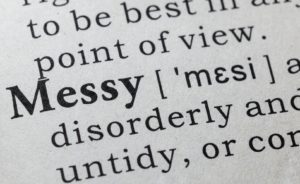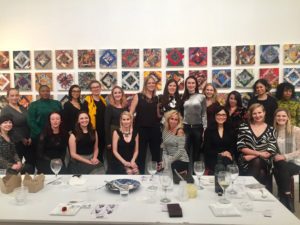I’ve just returned from a vacation in New Mexico. My soul was replenished with the big blue skies and hikes in the mountains, as well as the dozens of untold stories of strong women who helped make the southwest. Tears came to me when I learned at the Indian Pueblo Cultural Center in Alburquerque about the long traditions in pueblo cultures of honoring and respecting women. They introduce themselves as the son or the daughter of the mother – it is a matriarchal lineage.
The Cultural Center stressed the oral culture of passing down traditions, language and knowledge from generation to generation through the spoken word as lessons to guide beliefs and actions. The Center’s exhibit, “HERitage,” was filled with story after story that elevated the strength, power, resilience and persistence of Native women and what they accomplished for their communities. Taking in these stories made me even more aware of how few stories we are telling about women who support our nonprofits. Often the stories are right in front of us, if we take time to look.
When I work with clients to grow support from women I ask them to start by looking at their data. This analysis reveals stories of how women are already giving, and where the opportunities are if they design a way to intentionally elevate their respect and honor of all that women bring to their institutions.
I really get that looking at data can feel like a daunting task. When something is overwhelming and complex, I start with a first step. Just like creating a story, start with a simple opening and see where it goes. Sara Judge, Vice President of Development at Tufts University, suggests that it’s “important to start by developing the questions for which one seeks answers in the data.” Then follow the data-based answers that will lead to changed behavior and action with regard to women’s stories and their giving.
Simple questions might be how many women versus men are giving to you annually, or on your giving day, or in your campaign? How many women are in your leadership pipeline, or portfolios, or are featured on your website? What is the average size gift that women give versus men?
Many of my clients are finding that women are giving more often than men to an institution. This is to be celebrated! William and Mary just learned that more women than men gave to their recent and very successful For The Bold campaign. There is an important story in this data point – one worthy of exploring, writing up, and elevating for all to know.
At the same time, many clients often find when they review their data that women are not giving as much as men at the highest levels. This is where the opportunities lie! Remember that data only informs us of what has been. What are the stories of our behaviors that perhaps lead women to not give at higher levels? Is it in how we ask? How often we visit? How we partner with them as bold women who want impact?
Rachell Brandell-Mayers, Associate Director of Development Research at the University of Michigan, recently shared that through their analysis, they were able to attribute dollars left on the table. For every dollar a man gives to Michigan, women give 41 cents. As the team explored the data from a variety of perspectives, they determined that the differences were in how they were engaging women versus men in portfolios.
Data can also point to the conceivable story of your future. In analyzing alumnae giving, Tufts University found a potential opportunity to raise an additional $53 million by focusing intentionally on women. To learn this story, they focused on two key data-related questions: Is there a difference between men and women in their giving, in terms of size of gifts and giving to capacity? In looking at giving to capacity, how much money could the university raise if they increased women’s giving by 3%? 5%? 7%?
According to Sara, “the delta in giving between men and women – and the funds that could be realized by increasing women’s giving by a certain percentage – is one of the compelling points to convince leadership that it is worth the investment (staff, time, effort) to move forward with a women’s philanthropy initiative.”
Data is certainly a tool to grow your awareness. Most institutions now know that gender matters in philanthropy, thanks to more than 125 unique data points in the Women’s Philanthropy Institute’s research that reveal important differences in how women and men consider their philanthropy.
However, the power of data is when it helps you tell stories. Through your own data you will learn the current stories of how many women support you loyally and frequently. Stop right there and celebrate. Sing those facts out, honor women, bring them together so they can witness for themselves the impact they are already having.
Your data will also help you share your stories about gaps and all that is being left on the table. Be humble, be real. Tell the truth if there is still not equity in the number of women leaders versus men. Make your stakeholders aware if the amount women are giving might not be as high as men because we’ve not been valuing them. Make these facts real, authentic, and showcase that you get it and can do better. The Catholic Community Foundation of Minnesota (CCF) uncovered data that they are now sharing externally to note the imperative and opportunity to more strategically engage women as a core constituency.
And finally, data will also provide you the key facts for a story of a different future to share with your leaders. This is the persuasive story that makes leaders take notice and want to invest. This is often the same story that compels volunteers to come forward, hands raised and sleeves rolled up to do all they can to increase what women can do for your institution. CCF leaders have created an Advisory Committee filled with talented, committed women from all backgrounds helping them design how to lift up the collective impact of women’s giving and grow the networks of women supporting CCF.
I recently led a webinar on women’s philanthropy for Academic Impressions, a professional and leadership training institute for higher education. While the majority of participants shared in a poll that they know that gender matters in philanthropy, fewer than 25% of them look at their data through a gender lens.
I recognize that we have a long and successful heritage of fundraising in our country that continues to raise billions of dollars. Yet it is time to look at how we fundraise with new eyes. Focus on using data to find and amplify powerful women’s stories in order to shape your culture, values and future fundraising. You will not just bring in millions of previously untapped support. You will also gain the strength, power, resilience and persistence of women who care about your mission and the impact you can have on the world.






